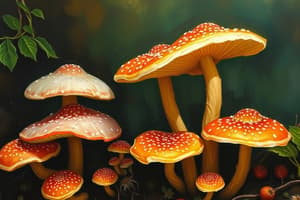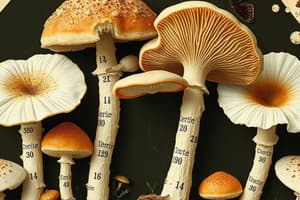Podcast
Questions and Answers
What type of fungi is characterized by growing as large single cells and being unicellular?
What type of fungi is characterized by growing as large single cells and being unicellular?
- Pseudohyphae
- Mould
- Yeast (correct)
- Dimorphic fungi
Which of the following accurately describes the structure of moulds?
Which of the following accurately describes the structure of moulds?
- They consist of multiple tubular branches. (correct)
- They do not have hyphae.
- They form multilayered sheets.
- They are unicellular and reproduce by budding.
What is a defining characteristic of yeasts compared to moulds?
What is a defining characteristic of yeasts compared to moulds?
- Yeasts do not have true hyphae, instead forming pseudo-hyphae. (correct)
- Yeasts are more colorful than moulds.
- Yeasts only exist in anaerobic conditions.
- Yeasts are eukaryotic while moulds are prokaryotic.
Where are yeasts commonly found?
Where are yeasts commonly found?
What health risk is associated with yeast infections?
What health risk is associated with yeast infections?
What feature distinguishes moulds from yeasts in terms of spore production?
What feature distinguishes moulds from yeasts in terms of spore production?
Which of the following colours is typically less associated with yeasts compared to moulds?
Which of the following colours is typically less associated with yeasts compared to moulds?
Which statement about the habitat of moulds is accurate?
Which statement about the habitat of moulds is accurate?
Flashcards
What is Yeast?
What is Yeast?
Fungi that grow as large single cells and are unicellular.
What is the structure of Moulds?
What is the structure of Moulds?
They consist of multiple tubular branches, forming a mycelium.
Defining characteristic of Yeasts?
Defining characteristic of Yeasts?
Yeasts do not have true hyphae and may form pseudo-hyphae.
Where are Yeasts found?
Where are Yeasts found?
Signup and view all the flashcards
Health risk of Yeast infections?
Health risk of Yeast infections?
Signup and view all the flashcards
Spore production: Moulds vs. Yeasts
Spore production: Moulds vs. Yeasts
Signup and view all the flashcards
Typical colour of Yeasts?
Typical colour of Yeasts?
Signup and view all the flashcards
Habitat of Moulds?
Habitat of Moulds?
Signup and view all the flashcards
Study Notes
Fungi
- Fungi are eukaryotic.
- Candida is the most important fungus relevant to dentistry.
- Fungi are present in 2 structural forms - yeast and mould.
- Dimorphic fungi can exist as both yeasts and moulds.
Yeast
- Grow as large single cells.
- Unicellular organisms.
- Exist in many habitats such as fruit, stomachs of mammals, the oral cavity and vaginal areas.
- Appear white and thready, usually oval shaped.
- Do not have true hyphae, but instead form pseudohyphae which are multicellular structures.
- Not a sporing species.
- Have a less colourful appearance compared to moulds, generally appearing yellow, creamy, or colourless.
- Can grow in both aerobic and anaerobic conditions.
- Can cause infections in individuals with compromised immune systems.
- Often seen to have lateral projections called daughter cells.
- Yeast splits from a mother cell to produce the next generation - known as budding.
- Some yeasts reproduce by binary fission.
- Pseudohyphae are chains of elongated budding cells.
- Candida forms pseudohyphae in the oral cavity.
Mould
- Grow as multiple tubular branches.
- Multicellular organisms.
- Typically found in damp, dark, or humid areas.
- Have a fluffy appearance and are found in various shapes.
- Have microscopic filaments called hyphae.
- Are a sporing type of fungus.
- Have a colourful appearance with colours like orange, green, black, brown, pink, or purple.
Studying That Suits You
Use AI to generate personalized quizzes and flashcards to suit your learning preferences.




